Marshall "Major" Taylor Historical Marker
Introduction
Text-to-speech Audio
This historic marker honors Indianapolis-born Marshall Walter Taylor, a champion cyclist of international fame who was often barred from competition due to the color of his skin. At the turn of the century, cycling was one of the most popular sports and Taylor may have been the fastest cyclist in the world. In 1896, for example, Taylor set two records at an Indianapolis track, only to be banned from future competition. Taylor was barred from competition with white cyclists in South. Even when he was allowed to participate in races in Northern cities like New York and Chicago, Taylor endured violent attacks by cycling fans and other competitors. The climate was less hostile in international competitions, allowing Taylor to set world records in Canada, Europe, and Australia. Marshall retired from professional racing in 1910.
Images
Historic Marker commemorating Marshall "Major" Taylor
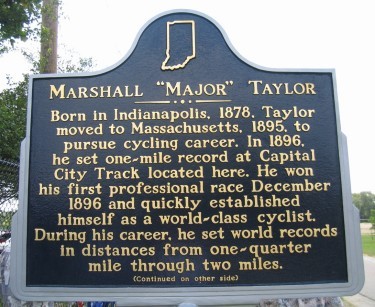
Taylor, in the lead, racing in Paris in 1908.
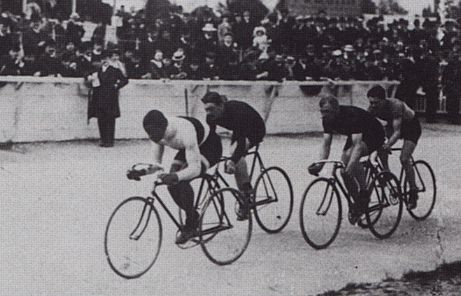
Marshall Taylor circa 1900.
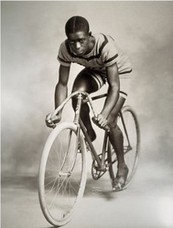
Andrew Ritchie, Major Taylor: The Extraordinary Career of a Champion Bicycle Racer. For more info about this book, please click the link below
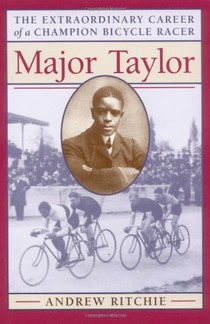
1897 sketch of Taylor as found in the Boston Daily Globe
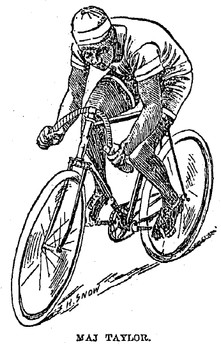
Backstory and Context
Text-to-speech Audio
During the 1870s and 1880s, most bicycles featured a rider atop one large wheel that was stabilized by a second smaller wheel. Known as high wheelers, penny-farthings, or ordinaries, these cycles were impractical and even dangerous. With the adaptation of the chain drive and pneumatic tires in the early 1890s, bicycling transitioned from the high-wheeling hobby of wealthy men to a practical means of transportation and recreation. In the 1890s, the sport of cycling took the nation by storm.
“Taylor was a marvel on a bicycle. Riding against the fastest bicyclists of America, Europe and Australia, he won national and world championships against racial prejudice, unscrupulous tactics of riders and unfair decisions of officials.” Chicago Defender, July 2, 1932
Taylor was born in Indianapolis in 1878. After moving to Chicago with the family who employed his father, Taylor began to earn money as a paperboy, using the bicycle his "adopted" father gave him. He rode for miles each day and gradually learned to perform stunts and tricks on the bicycle, which got the attention of the Hay and Willis bicycle shop. He was soon hired by the shop to perform stunts in front of the store to attract shoppers. At the urging of the shop owner, Taylor entered and won his first race, finishing six seconds ahead of everyone else. At the age of 13, Taylor's speed earned him a mention in the New York Times. Known as the "Black Cyclone," Taylor won the world championship of cycling in 1899.
The victory earned Taylor fame and admiration, but Jim Crow laws prevented him from competing in races in the South. In the instances in which Taylor was allowed to compete, he was often harassed by white cyclists and spectators. At a race in Massachusetts, Taylor was attacked from behind by W.E. Becker, a fellow cyclist, and choked until he was unconscious.
Taylor's backers urged him to compete in Europe, where he would be free of the racist backlash he encountered in the United States. Knowing that some of the most prestigious French events were held on Sundays, Taylor resisted for years because his religious convictions prevented him competing in those events. Eventually he relented after the days of the events were changed to accommodate his beliefs. As he had done in the United States, Taylor won most of the races in which he competed, and solidified his reputation as the fastest cyclist in the world.
By the early 1900s, Taylor was earning enough to make him one of the wealthiest athletes of his time. With the advent of the automobile, however, interest in cycling declined and Taylor retired at 32. By the end of his life, Taylor's fortune had largely been lost and his marriage ended. At his death, his body was unclaimed and he was eventually buried in a pauper's grave in Chicago. Eventually Frank Schwinn, the owner of the Schwinn Bicycle Company, paid to have Taylor's remains moved and given a fitting memorial.
Marshall "Major" Taylor was the subject of a 1992 mini-series: "Tracks of Glory" TV mini-series (starring: Philip Morris). a.k.a. "Tracks of Glory: The Major Taylor Story."
“Taylor was a marvel on a bicycle. Riding against the fastest bicyclists of America, Europe and Australia, he won national and world championships against racial prejudice, unscrupulous tactics of riders and unfair decisions of officials.” Chicago Defender, July 2, 1932
Taylor was born in Indianapolis in 1878. After moving to Chicago with the family who employed his father, Taylor began to earn money as a paperboy, using the bicycle his "adopted" father gave him. He rode for miles each day and gradually learned to perform stunts and tricks on the bicycle, which got the attention of the Hay and Willis bicycle shop. He was soon hired by the shop to perform stunts in front of the store to attract shoppers. At the urging of the shop owner, Taylor entered and won his first race, finishing six seconds ahead of everyone else. At the age of 13, Taylor's speed earned him a mention in the New York Times. Known as the "Black Cyclone," Taylor won the world championship of cycling in 1899.
The victory earned Taylor fame and admiration, but Jim Crow laws prevented him from competing in races in the South. In the instances in which Taylor was allowed to compete, he was often harassed by white cyclists and spectators. At a race in Massachusetts, Taylor was attacked from behind by W.E. Becker, a fellow cyclist, and choked until he was unconscious.
Taylor's backers urged him to compete in Europe, where he would be free of the racist backlash he encountered in the United States. Knowing that some of the most prestigious French events were held on Sundays, Taylor resisted for years because his religious convictions prevented him competing in those events. Eventually he relented after the days of the events were changed to accommodate his beliefs. As he had done in the United States, Taylor won most of the races in which he competed, and solidified his reputation as the fastest cyclist in the world.
By the early 1900s, Taylor was earning enough to make him one of the wealthiest athletes of his time. With the advent of the automobile, however, interest in cycling declined and Taylor retired at 32. By the end of his life, Taylor's fortune had largely been lost and his marriage ended. At his death, his body was unclaimed and he was eventually buried in a pauper's grave in Chicago. Eventually Frank Schwinn, the owner of the Schwinn Bicycle Company, paid to have Taylor's remains moved and given a fitting memorial.
Marshall "Major" Taylor was the subject of a 1992 mini-series: "Tracks of Glory" TV mini-series (starring: Philip Morris). a.k.a. "Tracks of Glory: The Major Taylor Story."
Sources
Indiana Historical Bureau, http://www.in.gov/history/markers/MajorTaylor.htm accessed 10/31/15
Autobiography: The Fastest Bicycle Rider in the World, 1929
Major Taylor: The Extraordinary Career of a Champion Bicycle Racer by Andrew Ritchie, 1988
Major Taylor, Champion Cyclist by Lesa Cline-Ransome
Major: A Black Athlete, a White Era, and the Fight to Be the World's Fastest Human Being by Todd Balf.
Major Taylor: The Inspiring Story of a Black Cyclist and the Men Who Helped Him Achieve Worldwide Fame, by Conrad Kerber and Terry Kerber, Skyhorse Publishing, 2014
"Who was Major Taylor". Bridgewater, Connecticut: Bridgewater State University. November 17, 2004. Archived from the original on February 21, 2017.
Autobiography: The Fastest Bicycle Rider in the World, 1929
Major Taylor: The Extraordinary Career of a Champion Bicycle Racer by Andrew Ritchie, 1988
Major Taylor, Champion Cyclist by Lesa Cline-Ransome
Major: A Black Athlete, a White Era, and the Fight to Be the World's Fastest Human Being by Todd Balf.
Major Taylor: The Inspiring Story of a Black Cyclist and the Men Who Helped Him Achieve Worldwide Fame, by Conrad Kerber and Terry Kerber, Skyhorse Publishing, 2014
"Who was Major Taylor". Bridgewater, Connecticut: Bridgewater State University. November 17, 2004. Archived from the original on February 21, 2017.
